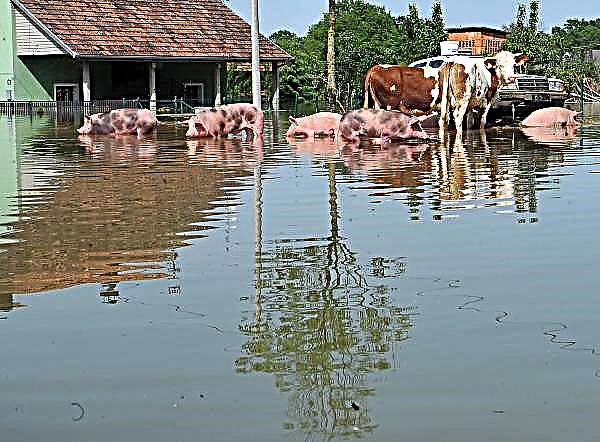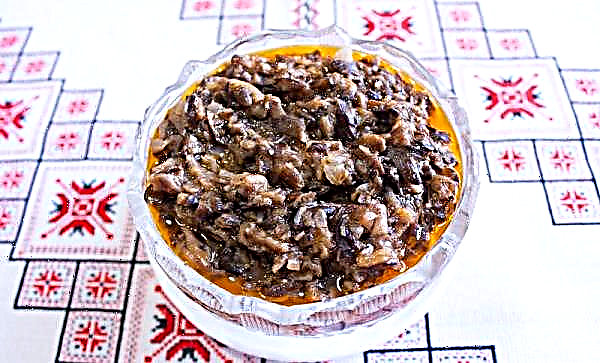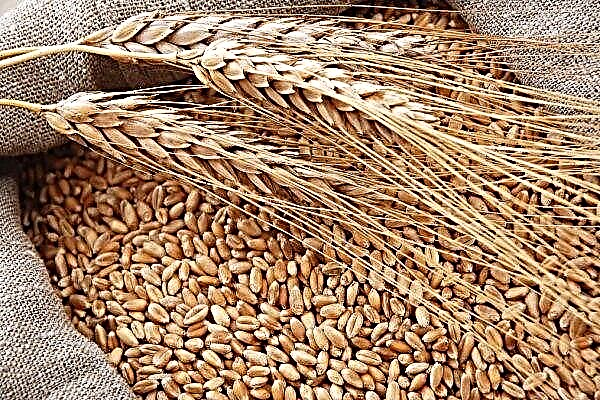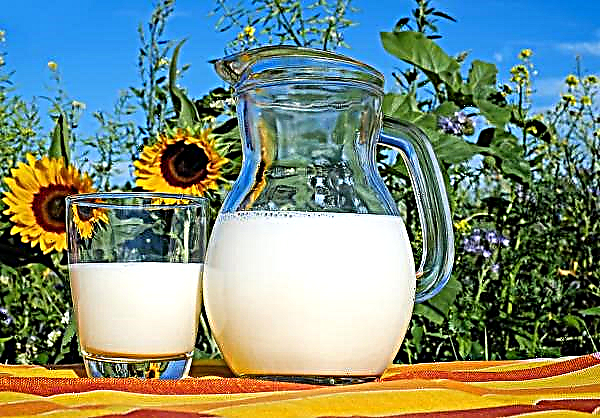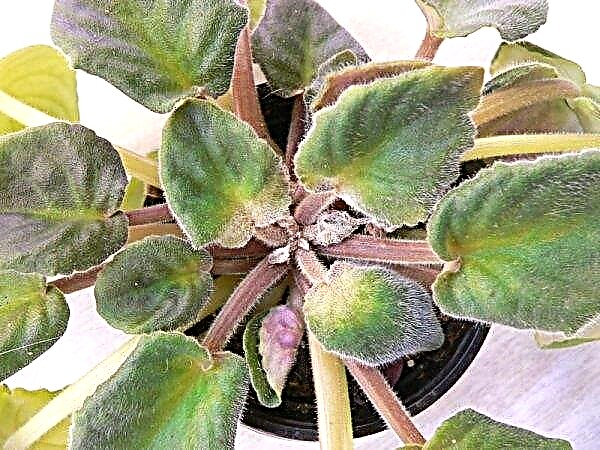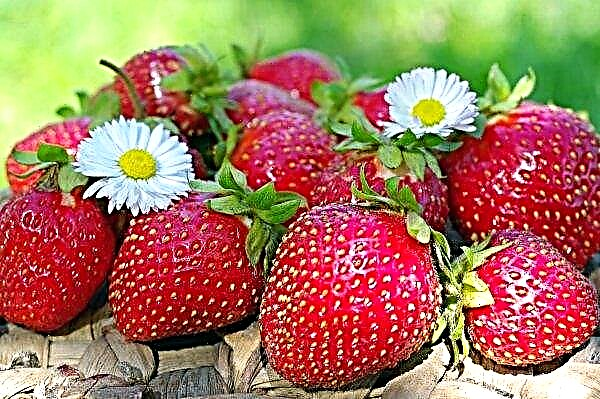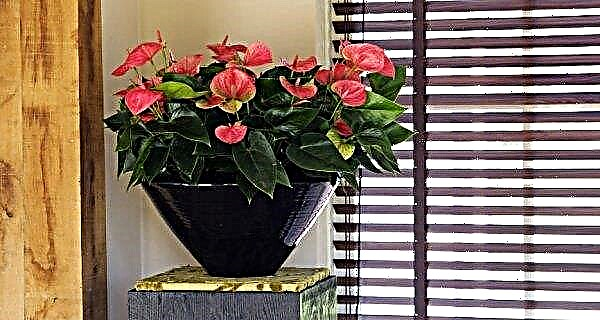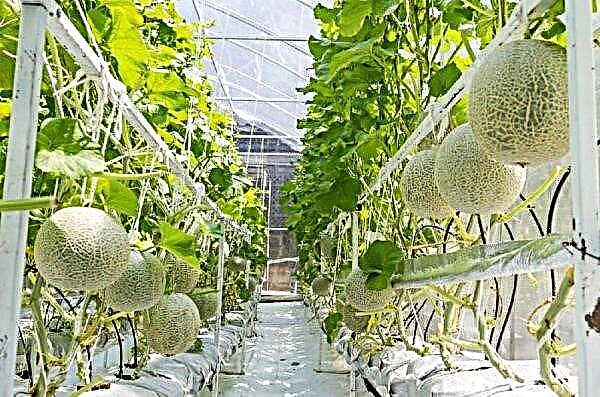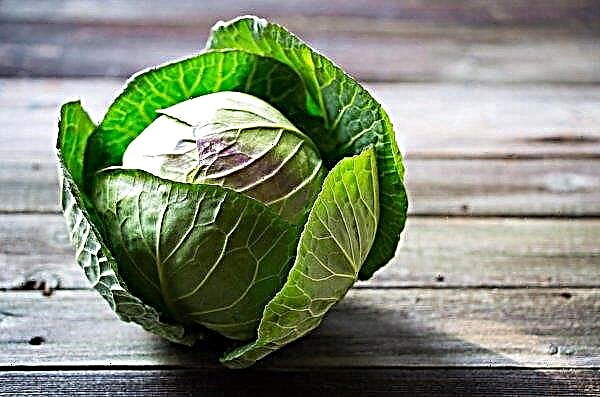Geranium is able to decorate both a garden plot and a house. In the article we will talk about one of the species of this plant - garden geranium. You will learn about the most common varieties of this crop, how to plant it, where to grow it and how to care for it.
Varieties of garden geraniums
Garden geranium is a perennial undersized flowering plant, which is characterized by picturesque decorativeness, rapid growth, winter hardiness, ease of care. Breeders have bred many varieties of this species.
The most popular of them are the following:
- Large-rhizome (Balkan). It has a long, powerful root, which is located on the surface. The crown of the plant is dense. Elongated leaves are located on long petioles up to 20 cm long. Peduncles in the form of umbrellas. Flowers with a diameter of up to 3 cm purple, reddish, white-pink, cream color. Flowering begins in June, lasts 2–4 weeks.

- Large-flowered (Himalayan). Ground cover plant with rounded leaves and large flowers with a diameter of 4-5 cm. Flowers are placed on the same peduncle. By color, they are blue with a purple tint and dark veins. The beginning of flowering occurs in May - June. Flowering time - 3 months.
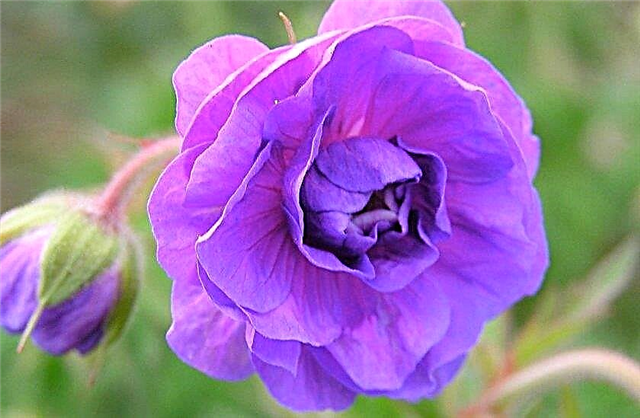
- Georgian. A flower with a powerful bush up to 80 cm high and a short root. The leaves have a rounded shape, located on long petioles. They are dissected and have serrations along the edges, pubescent. In autumn, green leaves turn red. Flowers appear in the middle of the first summer month. They are medium in size - up to 4.5 cm across, purple. Long flowering - until the end of autumn.

- Blood red. It features a long rhizome. Leaves give the flower a decorative effect until winter: at first they are green, and by autumn they get a red tint. The bush forms a spherical shape. Blooming in bright red is observed throughout the summer. The life span of blood red geraniums is about 15 years.

- Meadow. Grows in a tall bush. It forms tall, hairy shoots, pubescent seven-leaf leaves and large lilac flowers. Flowering does not last long - from June to July.

- Gorgeous (lush). The flower is characterized by rapid growth, large bush, lush flowering. He forms purple inflorescences, five-branched pubescent serrated leaves. At first, green leaves in the fall do not lose their decorativeness; they become orange or red.

Methods of propagation of garden geraniums
Geranium can be propagated in several ways.
Most commonly used:
- seminal;
- cuttings;
- division of the bush.
Did you know? The name "geranium" comes from the ancient Greek language. It translates as "crane". The flower received such a name because of the similarity of the fruits to the long beak of this feathered.
Seeds
The seed material and the substrate for its germination are purchased in a specialized store. Landing should be carried out in February in room conditions.
The technology for sowing and growing seedlings is as follows:
- Sow in a loose moist substrate to a depth of 5 mm.
- Humidify with a spray gun.
- Cover with glass and put in a well-lit warm place.
- Open daily for fresh air.
- Moisten as the top soil layer dries.
- After the formation of 2 real sheets, pick in separate pots.
- Continue watering.
- Make 1-2 fertilizer fertilizers for flowering plants.
- After the formation of 5-6 leaves, transplant into the ground at a constant place.

Dividing the bush
The division of the bush is carried out during a transplant in the fall.
For its implementation, the following manipulations should be carried out:
- A day before propagation, water the flower abundantly.
- Remove it from the ground.
- Carefully remove the earthen lump.
- Divide the plant into 2 or more parts.
- Plant parts in separate pots or soil.

Cuttings
Cuttings are the cultivation of a flower from a shoot cut off from the mother plant. This method is the most simple and affordable for every grower. With this reproduction, all the qualities of the uterine plant are preserved. It is produced in the spring or autumn.
Cutting technology is as follows:Did you know? Geranium oil is used in aromatherapy. It is recommended to inhale its smell for those who have loosened nerves, there is stress, depression or a bad mood.
- Sanitize and sharpen a knife or scissors.
- Cut off cuttings at an angle of 45 ° with 2-3 leaves and internodes 10 cm long.
- Tear off all the buds and 2 lower leaves.
- Place the cuttings for drying in a shaded place.
- To process the drug "Kornevin."
- Put the cuttings for rooting in water or plant in a nutrient substrate (universal soil with vermiculite and sand), and then place them in a room with room temperature.
- Water as needed, avoiding water entering the stem.
- After a month, rooted cuttings can be planted in the ground.
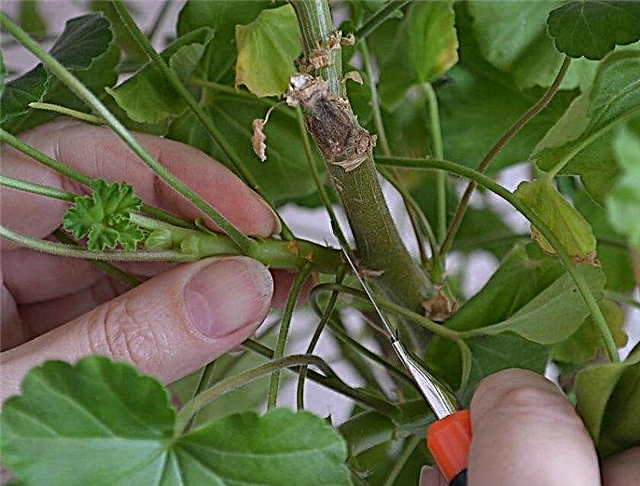
How to transplant geraniums to a permanent place?
If the flower grows in a region with mild winters, then it can be grown continuously in an open flower garden, covering in the cold season. In regions with severe winters, transplanting for the winter in pots and indoor cultivation will be required.
Also, some varieties of geranium, which are compact, can be planted in:
- pots;
- cache-pot;
- boxes.
Pot selection
The size of the pot will depend on the variety that is selected and the length of the rhizome. The depth of the container should be 15 cm greater than the length of the root. It is not recommended to plant geranium in oversized pots. This will affect the abundance of flowering - the plant will grow roots and foliage. More flowers appear when the container is a bit cramped.
Recommended pot material is ceramic. If the plant grows in the tank only in the winter, then the plastic version is also suitable. For further transplants, the containers should be made of the same material as for the initial landing.
The bottom of the pot must be covered with a drainage layer of 2-3 cm.
Important! Before planting, the ceramic pot needs to be washed well and kept in boiling water for some time.
Soil preparation
When grown indoors, you will need to purchase nutritious soil for flowering plants or universal soil in the store. In an open flower garden, the soil must be saturated with nutrients. Organic fertilizers such as peat or manure are best.
The soil should be loose, pass air and moisture well. Although geranium is also taking root in loam.
Acidity for a flower is the best neutral and slightly acidic soil. Wetlands and lowlands where water stagnates should be avoided. In such places, geraniums do not take root for a long time.
Landing technology
Geraniums are planted in open ground in the spring - in April - May. In the autumn period, it may not have time to acclimatize before the onset of frost and die. When grown indoors, planting can be done at any time except winter.
Plants are placed in an open flowerbed at a minimum distance of 30 cm from each other. Wells are prepared in advance. They should be 2 times wider and deeper than the earthen lump in which the flower grew.
The plant must be placed in a moistened hole with an earthen lump. Top lump sprinkled with earth. Water abundantly. And sprinkle dry soil.

Cultivation and care
Garden geranium, in contrast to its capricious roomy relatives, is a "flower for the lazy." It does not require special and frequent care measures, rarely gets sick, and endures unfavorable weather conditions.
Optimal conditions
For this decorative plant, you can choose a sunny, semi-shaded or shaded area. The greatest decorativeness can be achieved from flowers that grow in partial shade, for example, under the crowns of trees.
Geranium feels good at an air temperature of +20 ... + 23 ° С in warm time and + 15 ° С - in cold.
Watering and feeding
Watering should be moderate and regular. Geranium will be able to endure short-term drought, but it is better not to bring the soil to this. It must be controlled that the topsoil does not remain dry for a long time. In summer, you can drink a flower more abundantly. However, it must be remembered that he does not like waterlogging. With constantly wet soil, there is a high risk of root decay and plant death.
For irrigation use water at room temperature. Otherwise, the plant may be sick.
Spraying for geraniums is not needed. After each irrigation and rainfall, it is necessary to loosen the soil in order to prevent the formation of crust and improve its air and moisture permeability.
To keep moisture better, you can mulch the trunk area.
Fit:
- peat;
- wood chips;
- straw;
- mowed grass.
To achieve maximum decorativeness and endurance of the plant, it must be fed during the growing season. It is advisable to apply fertilizer every 2–4 weeks. Suitable supplements designed for flowering plants will do. Before flowering, nitrogen supplements are needed, during flowering (starting from mid-summer) - phosphorus and potassium.Important! Water the geraniums under the root. It is necessary to ensure that water does not fall on the leaves and stems, since the remaining drops, creating the effect of the lens, can provoke sunburn.
Cropping and shaping the crown
To form a beautiful, well-groomed bush, the flower must be cut in the spring. When pruning, damaged, diseased, weak shoots are removed. In those shoots that have reached a length of more than 15 cm, the tops are shortened by a couple of centimeters. This procedure stimulates the formation of lateral sprouts. After the lateral sprouts reach a length of 5 cm, they are shortened by 1 cm.
An important condition for lush and prolonged flowering is the timely removal of faded inflorescences. You need to do this regularly.
Transfer
A transplant garden geranium does not tolerate well. It is produced only when necessary and rather rarely (1 time in 3-4 years) by the method of transshipment, that is, preserving the whole earthen lump.
Reasons for transplanting geraniums growing in a pot are:
- the roots are visible from the drainage holes and are on the surface of the earth;
- painful appearance of the plant (yellowing, wilting, decay);
- stunting with proper care;
- strong exposure of the lower part of the stem.
For transplanting, such soil options are suitable:Important! If the soil is prepared on its own, then it must be disinfected by watering with a 1% potassium permanganate solution or by calcining in the oven at a temperature of +70 ... + 90 ° С.
- purchased soil intended for geranium + sand;
- purchased universal soil (10 parts) + moss-sphagnum (1 part) + humus (0.5 parts);
- garden soil + peat + sand (in equal parts);
- turf soil (4 parts) + humus (1 part) + sand (0.5 parts).
Video: How to transplant geranium easily, simply and without problems
Winter preparations
In a temperate climate, the plant is not dug up. Its ground part is cut off, leaving a small stump, and then shelter from humus, dry leaves, straw. In the spring, shelter is removed.
Major diseases, pests and their control
If mistakes are made during planting or care, the plant may be sick or affected by pests.
Most often, infection with such diseases occurs:
- Leaf spotting. Signs are brown, brown, light green spots on the foliage. Sick organs must be destroyed by burning. If the disease is at the initial stage, then treatment with biofungicides - “Fitosporin-M”, “Haupsin” will help. With severe infection, connection of stronger drugs will be required.

- Powdery mildew. Symptoms - white powdery coating on the leaves. For treatment, fungicides and colloidal sulfur are used.

- Gray rot. It appears gray spots on the leaves. It is treated with Fundazol, Vitarol, Rovral.

Of the pests, geraniums can most often affect:Did you know? All organs of geranium have medicinal properties. They are used to prepare remedies for various diseases in official medicine and folk healing.
- Ticks. The fact that they wound up on a flower will tell the small yellow dots on the foliage. These parasites like to breed actively in hot and dry periods. The fight against them consists in wiping with soap and water, treatment with the Fitoverm, Bi-58, Karate, Iskra-M, and Aktellik insecticides.

- Aphid. This dangerous harmful insect, when massed on a plant, can literally drink all the juices from it and lead to death. Signs of infection - yellowing and curling leaves, lethargy, leaf fall. Ways to combat aphids are the same as with a tick.

- Whitefly. To notice the presence of this pest is simple - white butterflies fly over the flowers. However, the danger is not moths, but their larvae, which feed on leaves. You can fight whitefly with herbal decoctions and infusions, tobacco infusion. In case of severe infection, spraying with chemicals - Actellik, Fitoverm, Aktara, Fufanon will be required.
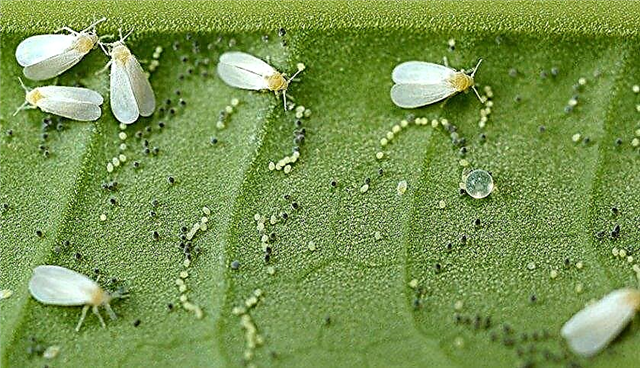
- Leaves turn yellow and dry ends. One possible reason is lack of moisture. Missing leaves need to be removed, and watering should be gradually increased.
- No bloom. There are several reasons: lack of light, cold temperatures, lack of mineral elements, long absence of pruning.
- The formation of brown growths on the underside of the leaf. The reason is a strong hydration of the roots and high humidity. Urgently need to reduce irrigation and to establish their regime.
Important! Yellowing foliage in geraniums some time after planting is the norm. Yellow leaves need to be removed and quality plant care should be organized. After a while, the flower adapts.
Use in landscape design
Today, designers plant various types and varieties of garden geraniums in such compositions:
- alpine hill;
- border;
- rockery;
- mixed flower beds against the background of tall plants;
- single plantings in the center of the lawn (individual varieties);
- mixborder.

Summing up, we note that garden geranium is a beautiful and unpretentious plant that, with proper care, can please its owner with long flowering for many years. The flower is not afraid of frost, can be grown in open and closed ground. The main thing that he needs is the choice of the right place and soil, and a competent landing.
















